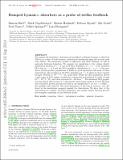| dc.contributor.author | Bird, Simeon | |
| dc.contributor.author | Vogelsberger, Mark | |
| dc.contributor.author | Haehnelt, Martin | |
| dc.contributor.author | Sijacki, Debora | |
| dc.contributor.author | Genel, Shy | |
| dc.contributor.author | Torrey, Paul | |
| dc.contributor.author | Springel, Volker | |
| dc.contributor.author | Hernquist, Lars | |
| dc.date.accessioned | 2015-09-11T12:29:55Z | |
| dc.date.available | 2015-09-11T12:29:55Z | |
| dc.date.issued | 2014-10 | |
| dc.date.submitted | 2014-09 | |
| dc.identifier.issn | 0035-8711 | |
| dc.identifier.issn | 1365-2966 | |
| dc.identifier.uri | http://hdl.handle.net/1721.1/98455 | |
| dc.description.abstract | We examine the abundance, clustering and metallicity of Damped Lyman α Absorbers (DLAs) in a suite of hydrodynamic cosmological simulations using the moving mesh code arepo. We incorporate models of supernova and AGN feedback, as well as molecular hydrogen formation. We compare our simulations to the column density distribution function at z = 3, the total DLA abundance at z = 2–4, the measured DLA bias at z = 2.3 and the DLA metallicity distribution at z = 2–4. Our preferred models produce populations of DLAs in good agreement with most of these observations. The exception is the DLA abundance at z < 3, which we show requires stronger feedback in 10[superscript 11–12] h[superscript −1] M[subscript ⊙] mass haloes. While the DLA population probes a wide range of halo masses, we find the cross-section is dominated by haloes of mass 10[superscript 10]–10[superscript 11] h[superscript −1] M[subscript ⊙] and virial velocities 50–100 km s[superscript −1]. The simulated DLA population has a linear theory bias of 1.7, whereas the observations require 2.17 ± 0.2. We show, however, that non-linear growth increases the bias in our simulations to 2.3 at k = 1 h Mpc[superscript −1], the smallest scale observed. The scale-dependence of the bias is, however, very different in the simulations compared against the observations. We show that, of the observations we consider, the DLA abundance and column density function provide the strongest constraints on the feedback model. | en_US |
| dc.language.iso | en_US | |
| dc.publisher | Oxford University Press | en_US |
| dc.relation.isversionof | http://dx.doi.org/10.1093/mnras/stu1923 | en_US |
| dc.rights | Creative Commons Attribution-Noncommercial-Share Alike | en_US |
| dc.rights.uri | http://creativecommons.org/licenses/by-nc-sa/4.0/ | en_US |
| dc.source | arXiv | en_US |
| dc.title | Damped Lyman α absorbers as a probe of stellar feedback | en_US |
| dc.type | Article | en_US |
| dc.identifier.citation | Bird, S., M. Vogelsberger, M. Haehnelt, D. Sijacki, S. Genel, P. Torrey, V. Springel, and L. Hernquist. “Damped Lyman Absorbers as a Probe of Stellar Feedback.” Monthly Notices of the Royal Astronomical Society 445, no. 3 (October 17, 2014): 2313–2324. | en_US |
| dc.contributor.department | Massachusetts Institute of Technology. Department of Physics | en_US |
| dc.contributor.department | MIT Kavli Institute for Astrophysics and Space Research | en_US |
| dc.contributor.mitauthor | Vogelsberger, Mark | en_US |
| dc.relation.journal | Monthly Notices of the Royal Astronomical Society | en_US |
| dc.eprint.version | Author's final manuscript | en_US |
| dc.type.uri | http://purl.org/eprint/type/JournalArticle | en_US |
| eprint.status | http://purl.org/eprint/status/PeerReviewed | en_US |
| dspace.orderedauthors | Bird, S.; Vogelsberger, M.; Haehnelt, M.; Sijacki, D.; Genel, S.; Torrey, P.; Springel, V.; Hernquist, L. | en_US |
| dc.identifier.orcid | https://orcid.org/0000-0001-8593-7692 | |
| mit.license | OPEN_ACCESS_POLICY | en_US |
| mit.metadata.status | Complete | |
